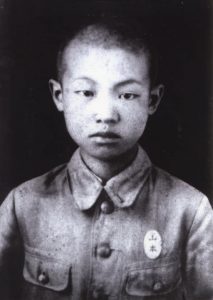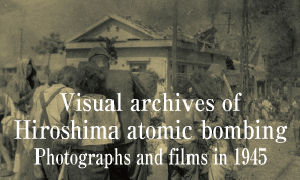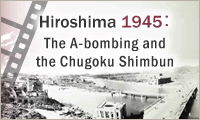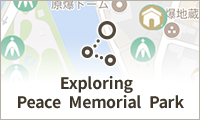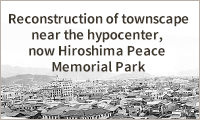Documenting Hiroshima of 1945: September 16, Hiroshima moves toward reconstruction even amid rising death toll in city
Sep. 16, 2024
by Kyosuke Mizukawa, Senior Staff Writer
On September 16, 1945, Tatsuya Yamamoto, 14 at the time, who was a second-year student at Hiroshima Municipal Middle School (present-day Motomachi High School), passed away at his home in the area of Kusatsuhigashi-machi (in the city’s present-day Nishi Ward). Mr. Yamamoto had suffered severe burns over his entire body after being exposed to thermal rays from the atomic bombing on the school’s grounds, located around 1.4 kilometers from the hypocenter.
On August 6, he fled the city area as it became engulfed in flames with encouragement from Akihiro Takahashi, a classmate who experienced the bombing on the same school grounds and died in 2011 at the age of 80. In his personal account of that time, Mr. Takahashi wrote that Tatsuya had continued to sob while calling out, “Mother, mother.”
After Tatsuya managed to return home, his mother, Sueko, cut away with a pair of scissors his clothing, which had stuck to his skin due to the burns, and applied grated potatoes to his wounds because no burn medications were available. Despite her desperate efforts to care for her son for more than one month, Tatsuya died while calling for his mother.
Mr. Takahashi, who later served as director of the Hiroshima Peace Memorial Museum, continued to communicate the story of Tatsuya’s death in the atomic bombing through his personal accounts and testimonies of his experiences. He said he believed that, “As someone who survived, I had to do something on behalf of my friends.”
Even as the death toll continued to rise, members of the public who had survived were already working on rebuilding the city. On September 16, the Chugoku Shimbun newspaper reported that preparations were underway to resume classes at Hiroshima University of Literature and Science (present-day Hiroshima University) and other schools.
Shacks appeared in the central area of the city’s ruins. According to the publication Record of the Hiroshima A-bomb War Disaster, published in 1971, the area of Shimoyanagi-cho (in Hiroshima’s present-day Naka Ward), on which barracks were erected relatively early on, was inhabited by seven families living on the incinerated ruins as of the end of August. At first, for the families to live, roofs were made from burnt corrugated metal, under which woven mats and other metal sheeting were spread out on the ground. About one month after the bombing, inhabitants covered the roofs and laid flooring after collecting wood and rooftiles that had survived the fires.
Nevertheless, a fierce typhoon, which would destroy the shacks erected with great effort, was fast approaching the city.
(Originally published on September 16, 2024)
On September 16, 1945, Tatsuya Yamamoto, 14 at the time, who was a second-year student at Hiroshima Municipal Middle School (present-day Motomachi High School), passed away at his home in the area of Kusatsuhigashi-machi (in the city’s present-day Nishi Ward). Mr. Yamamoto had suffered severe burns over his entire body after being exposed to thermal rays from the atomic bombing on the school’s grounds, located around 1.4 kilometers from the hypocenter.
On August 6, he fled the city area as it became engulfed in flames with encouragement from Akihiro Takahashi, a classmate who experienced the bombing on the same school grounds and died in 2011 at the age of 80. In his personal account of that time, Mr. Takahashi wrote that Tatsuya had continued to sob while calling out, “Mother, mother.”
After Tatsuya managed to return home, his mother, Sueko, cut away with a pair of scissors his clothing, which had stuck to his skin due to the burns, and applied grated potatoes to his wounds because no burn medications were available. Despite her desperate efforts to care for her son for more than one month, Tatsuya died while calling for his mother.
Mr. Takahashi, who later served as director of the Hiroshima Peace Memorial Museum, continued to communicate the story of Tatsuya’s death in the atomic bombing through his personal accounts and testimonies of his experiences. He said he believed that, “As someone who survived, I had to do something on behalf of my friends.”
Even as the death toll continued to rise, members of the public who had survived were already working on rebuilding the city. On September 16, the Chugoku Shimbun newspaper reported that preparations were underway to resume classes at Hiroshima University of Literature and Science (present-day Hiroshima University) and other schools.
Shacks appeared in the central area of the city’s ruins. According to the publication Record of the Hiroshima A-bomb War Disaster, published in 1971, the area of Shimoyanagi-cho (in Hiroshima’s present-day Naka Ward), on which barracks were erected relatively early on, was inhabited by seven families living on the incinerated ruins as of the end of August. At first, for the families to live, roofs were made from burnt corrugated metal, under which woven mats and other metal sheeting were spread out on the ground. About one month after the bombing, inhabitants covered the roofs and laid flooring after collecting wood and rooftiles that had survived the fires.
Nevertheless, a fierce typhoon, which would destroy the shacks erected with great effort, was fast approaching the city.
(Originally published on September 16, 2024)

